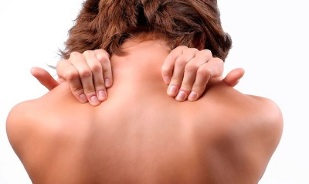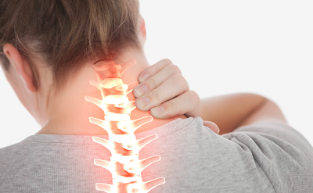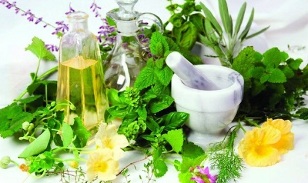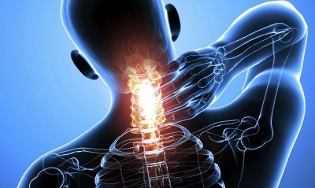
Osteochondrosis is a degenerative disease of the spine, manifested in deformation of bone tissue and intervertebral discs.
The first symptoms may appear as early as 20-30 years, but more often the disease becomes noticeable up to 40 years. It is divided into three categories - osteochondrosis of the lumbar, thoracic and cervical spine.
Reasons for development
The causes of the appearance and development of cervical osteochondrosis are divided into the following factors:
- hereditary predisposition to the disease;
- impaired metabolism, intoxication of the body, infectious diseases;
- overweight and increased stress on all parts of the spine, including the cervical;
- lack of fluid, vitamins or trace elements, poor nutrition;
- spinal injuries, bruises, fractures;
- climatic or environmental conditions that adversely affect the body;
- improper posture, curvature of the spine;
- flat feet, use high heels;
- sedentary, sedentary lifestyle;
- high activity requiring frequent changes in body position;
- frequent physical exertion of the spine;
- staying in an awkward position for a long time;
- stressful situations, nervous tension.
The onset of osteochondrosis is often associated with occupational activities. Constant physical activity, a high level of mobility, as well as sedentary work form the main risk group.
Another category of people prone to cervical osteochondrosis is formed due to objective and external exposure conditions. Heredity, climate, frequent hypothermia - all this contributes to the additional load on the spine. It also includes malnutrition and a lack of necessary substances that can prevent osteochondrosis in the cervical spine.
Improper sleeping position, prolonged immobility, especially in an awkward position, wearing uncomfortable shoes - all this forms another risk group. This includes pregnant women, especially when carrying several children or an underdeveloped musculoskeletal system.
Stages of development of osteochondrosis
The development of osteochondrosis is divided into four stages. The initial is characterized by the development of pathology of the pulpal nucleus. Lack of moisture and stress on the cervical vertebrae lead to deformation of the vertebrae and intervertebral discs and fibrous cracks appear.
Symptoms are usually absent at this stage. Their manifestation is reduced to minor pain in prolonged uncomfortable body position, as well as some discomfort during active movement.
By the beginning of the second stage of cervical osteochondrosis, the height of the intervertebral discs decreases. This reduces the distance between the vertebrae, relaxes the muscles and ligaments.
At this stage, the mobility of the affected vertebrae increases. This is expressed in expressive painful sensations with certain movements and positions. Discomfort can also occur under certain loads.
In the third stage of the development of cervical osteochondrosis, prolapses and protrusions of intervertebral discs form. Often the disease is accompanied by dislocations and osteoarthritis of the affected joints.
This stage of cervical osteochondrosis is often accompanied by stiffness in some movements. There is also a lack of mobility, numbness and tingling in the limbs. The pain in the neck becomes distinct.
The fourth stage of cervical osteochondrosis is characterized by the body's attempt to independently correct the increased mobility of the vertebrae. Osteophytes form at their points of contact, focused on trying to fix the desired position of the spine.
These bone formations often lead to nerve entrapment. Fibrous ankylosis begins to develop in the intervertebral discs and joints. When the nerve endings are compressed, the symptoms of osteochondrosis of the cervical spine intensify. However, if there are no pinches, the signs of the disease may disappear completely.
Symptoms

The symptoms of osteochondrosis of the cervical spine at different stages manifest themselves in different ways. Many patients in the early stages do not seek medical help.
Cases where consultation with a specialist is required include the following features:
- obsessive, non-disappearing at night, pain in the neck, eyes and ears, nape and shoulder girdle;
- frequent pain in the hands, exacerbated by exercise, muscle weakness;
- Difficulty moving the hands, reduced sensitivity and mobility of the hands and fingers;
- tingling, burning, tingling in the hands and feet;
- in the morning, there is tension in the muscles of the neck, there is a feeling of "laziness" and low mobility of the neck is established;
- pain when turning and tilting the head, periodically pulsating pain in the neck and nape;
- headache occurs, localized in the nape of the neck and spreads to the crown and temples;
- frequent dizziness, darkening of the eyes, fainting with a sharp turn of the head;
- tinnitus, the appearance of "flies" in front of the eyes, reduced visual acuity and hearing, numbness of the tongue;
- heart pain, the intensity of which depends on the posture and is not relieved by nitroglycerin;
- growth of connective tissue in the cervical spine.
The intensity of the symptoms of cervical osteochondrosis can manifest in different ways. Much depends on the location of complications - depending on which vertebrae are compressed nerve endings, the symptoms will also vary.
If the symptoms of osteochondrosis do not allow you to live and work properly, you should see a doctor.
Diagnostics
If severe symptoms of cervical osteochondrosis are found, they consult a local therapist. It can help determine the source of pain and provide a referral to a neurologist for further evaluation. A neurologist, depending on the diagnosis, is referred to in narrower specializations.
The vertebral neurologist deals with all issues in the treatment of the spine. A chiropractor can also help determine the diagnosis. In case of acute pain, they are referred to a traumatologist.
The process of diagnosing osteochondrosis can be done manually.
However, one of the following special procedures is used for the final diagnosis:
- X-ray of the cervical spine;
- myelography;
- neurological examination for limb sensitivity and reflexes;
- computed tomography of the cervical spine (CT); nuclear magnetic resonance (NMR);
- nuclear magnetic resonance (NMR).
Doppler ultrasound or duplex scanning may be prescribed to identify the condition of the vessels in osteochondrosis of the cervical spine. It is emphasized that only a suitable specialist can diagnose the disease.
Self-diagnosis and treatment of cervical osteochondrosis is not allowed.
How to treat osteochondrosis of the cervical spine?

The treatment of osteochondrosis of the cervical spine is prescribed in the form of complex therapy.
The following methods are included in the general procedure:
- taking medications that relieve symptoms and promote recovery;
- physiotherapy - water procedures, electrophoresis and other methods allow you to affect the spine in the right way;
- therapeutic gymnastics is considered an integral way to treat osteochondrosis of the cervical spine.
The main aspect of the treatment of cervical osteochondrosis is the integrated approach. Depending on the stage of the disease, the basic course can last 1-3 months. In addition, restorative and strengthening therapy is prescribed, which can be extended for another year.
First Aid
In case of exacerbation of osteochondrosis, first aid is usually reduced to medication. For severe pain, use standard painkillers.
If the effect of such drugs is absent, they turn to nonsteroidal anti-inflammatory drugs. However, these drugs can have a negative effect on the gastrointestinal tract. Without consulting a doctor, their use is allowed only in extreme cases.
The intensity of pain in osteochondrosis of the cervical spine is also relieved with anti-inflammatory painkillers.
In case of exacerbation of osteochondrosis, physiotherapy exercises are not used - the load can lead to an even greater complication. If the disease has already been diagnosed and the course of treatment is prescribed, follow the doctor's recommendations. Therapy usually involves a number of tools used to urgently eliminate the symptoms.
If this is the first manifestation of the disease - do not delay a visit to the doctor. Medications can relieve the pain, but complete diagnosis and treatment will be needed to prevent recurrence.
Physical education
The main cause of cervical osteochondrosis is the stress on this part of the spine. They can be expressed both in prolonged immobility with an awkward posture and in too intense mobility with a poorly developed musculoskeletal system.
Given this aspect, gymnastics and exercise are key therapies in the treatment of cervical osteochondrosis. You can do them in the morning and during the day, some can at work.
The whole set of actions is designed to strengthen the musculoskeletal system, improve blood circulation and restore the mobility of the vertebrae. Gymnastics can be used not only for the treatment but also for the prevention of osteochondrosis of the cervical spine.
Sitting and standing exercises
Gymnastics for the treatment of osteochondrosis of the cervical spine in a sitting and standing position includes the following actions:
- palm is placed on the forehead, pressed on it with the head, resisting the resistance of the hand to pressure, the procedure is repeated 3-4 times for 7-10 seconds;
- a similar process is done with the back of the head - the head is pressed against the opposite palm, tensing the muscles of the neck;
- then the procedure is performed in the same way with the right and left side of the head, placing a hand to the temple;
- as an alternative to the hand for the same exercises you can use a wall, in this case they rest on it with the forehead or nape and press for a few seconds;
- head is thrown back, overcoming the tension of the muscles of the neck, slowly tilted forward until the chin reaches the sternum, repeat 5-6 times;
- stand (sit) upright, turning your shoulders, slowly turning your head to the maximum possible right and left, repeat 5-6 times;
- the chin is lowered to the neck, in this position the head is also slowly turned left and right 5-6 times;
- head is slightly thrown back, tilted head left and right, trying to reach the corresponding shoulder with the ear, perform 5 times.
The exercise for the treatment of cervical osteochondrosis is repeated regularly. It is especially relevant for a sedentary lifestyle or for a long time in an awkward position.
Circular movements of the head are not suitable for loading; such exercises can cause neck injuries.
Exercises in lying
Lying down exercises for cervical osteochondrosis consist of the following actions:
- lie on their backs, stretching their legs, then pulling them to their chests, squeezing them with their hands, slowly raising their head, touching their knees with their foreheads, and then also slowly returning to their original position;
- the arms are spread wide to the sides and, lifting the body, reach with the right palm with the left and vice versa;
- lying on your stomach with outstretched legs and arms, lift your head and shoulders, leaning on your lower body;
- in the same position, the head rotates left and right, returning to its original position each time.
Lying down exercises for the treatment of osteochondrosis of the cervical spine are performed 4-5 times, the last - 8-10. In the course of performing any action, they observe the sensations; if pain occurs, the intensity of the load is reduced.
Drug therapy
In the treatment of osteochondrosis of the cervical spine, medication is aimed at eliminating the symptoms of the disease. Their supporting role is aimed at reducing pain, replenishing vitamins and increasing tissue regeneration.
Drugs used to treat cervical osteochondrosis are divided into the following categories:
- anti-inflammatory;
- antispasmodic;
- antioxidants;
- drugs to improve blood supply;
- increase cartilage tissue regeneration.
In the treatment of osteochondrosis of the cervical spine, the general list of prescribed drugs includes tablets, ointments, creams, in some cases, injections are prescribed. In case of significant pain, medications are used to relieve pain and block nerve endings.
In the absence of pain and destructive changes, taking medication may be completely unnecessary.
Folk remedies

In the treatment of cervical osteochondrosis, traditional medicine also offers an integrated approach. In addition to decoctions and tinctures, ointments based on herbs and products are used. Compresses are also made.
The main goal of folk remedies is to warm the affected area, as well as to give the body the necessary vitamins for recovery.
The use of prescriptions should be agreed with the doctor - some may interfere with prescribed medications or procedures.
Decoctions and tinctures
The following decoctions are prepared for oral use in the treatment of osteochondrosis of the cervical spine:
- celery root is cut through a grater, 3 grams are poured a liter of boiling water, insist 8 hours, filtered, consumed before meals three times a day, a teaspoon;
- sunflower root is crushed finely, a glass of raw materials is poured with three liters of water, boiled for half an hour, taken after meals in small quantities, helps to remove salts from the body;
- 2 tablespoons of yarrow flowers are poured with boiling water, infused for 30-40 minutes, drunk on a tablespoon three times a day, used as an anesthetic, anti-inflammatory and sedative;
- 3 tablespoons of burdock are crushed, poured with 250 grams of boiling water, insist two hours, a spoonful of honey is filtered and added, a quarter cup is drunk 4 times a day before meals;
- using a meat grinder, grind 3 large pitted lemons, 4 cloves of garlic, pour the mixture with two liters of boiling water, drink on an empty stomach, shaking the jar beforehand.
Compresses
Lotions and compresses are actively used in the treatment of osteochondrosis of the cervical spine:
- sprinkle cottage cheese with vinegar, stir and make a compress on the sore spot, wrapping it in a warm scarf, you can leave it overnight;
- add a gram of propolis, 50 grams of aloe extract, mustard powder to half a liter of vodka, soak the dressing with a solution, fix it and leave it overnight;
- one potato is passed through a grater, mixed with two tablespoons of honey, rubbed on the sore spot and then wrapped in a warm scarf for the night;
- tablespoon eucalyptus is poured a glass of water, boil for 5 minutes, add a tablespoon of honey, the mixture is applied to the sore spot for two hours.
Ointments
The following recipes are used to rub inflamed areas with osteochondrosis of the cervical spine:
- the flowers of the mother and stepmother, together with the stems, are flooded with ammonia, left to stand in a dark place for a month, they are used to lubricate the sore spot;
- prepare a mixture of ginger juice and pharmacy tincture of calendula, for sensitive skin is diluted with water in a ratio of 1: 1, used for rubbing before charging, helps relieve inflammation and improve blood circulation;
- half a packet of butter mixed with a tablespoon of flour and egg, then add a spoonful of vinegar, the mixture is poured a few days in a dark place, the resulting film is discarded, the solution is used for grinding in case of acute pain.
Massage

In the case of cervical osteochondrosis, massage can be an integral part of complex therapy. In this case, referral to a specialist is prescribed by the neurologist himself. In case of an independent massage solution, it is advisable to consult a doctor first.
Given the specifics of the disease, massage with osteochondrosis of the cervical spine should be treated carefully. The procedure is prescribed only when a disease is diagnosed, on the recommendation of a doctor and the presence of pain in the neck.
Massage contraindications for cervical osteochondrosis:
- There are tumors in the body, regardless of location;
- active tuberculosis; untreated sexually transmitted diseases;
- skin diseases at the site of inflammation, including moles, warts, cracks, abrasions;
- in diseases of the circulatory system, massage is included in the therapy at the discretion of the doctor;
- aneurysms, osteomyelitis.
If the procedure is prescribed by a specialist, no action is required.
Self-massage for osteochondrosis of the cervical spine is performed following clear instructions and rules:
- capture area - from the area of hair growth to the level below the shoulders;
- you can act with one or two hands at a time, depending on convenience;
- must follow a certain sequence of actions.
The massage procedure for osteochondrosis of the cervical spine includes the following steps:
- for half a minute, with your palm firmly pressed, stroke the skin in the area of inflammation;
- movements continue with pressure with the edge of the palm or with the pads of the fingers;
- fingers continue to rub, pulling the skin from the side to the spine;
- the skin is already mixed with muscle capture, the movements are maintained at an intense level, but without painful sensations;
- To finish, repeat the first step by rubbing your palm lightly.
It is recommended to repeat each action 6-7 times, taking half a minute of unhurried movements. With osteochondrosis of the cervical spine, self-massage can be difficult, which is why they turn to friends or relatives for help. However, a specialist remains recommended.
Nutrition
The complex treatment of cervical osteochondrosis includes dietary nutrition. It is focused on improving the metabolism, as well as saturating the body with the necessary minerals and vitamins, which contribute to the recovery and regeneration of tissues.
The basis of the diet for osteochondrosis of the cervical spine includes:
- dairy and fermented milk products;
- poultry meat, low fat, fish;
- fresh vegetables and fruits;
- nuts and seeds;
- cereals;
- mushrooms.
Recommended recipes for osteochondrosis of the cervical spine include fish and meat jellies, jelly meat, aspic dishes. Pay attention to the use of raw olive oil. Apply it without heat treatment. The food itself is preferably boiled, baked or steamed.
Food should be divided into 5-6 times. For proper absorption it is recommended to drink half a liter of fluid a day. Preference is given to pure and mineral water, dried fruit compotes, unsweetened fruit drinks, herbal tea.
In osteochondrosis of the cervical spine, limit the consumption of the following products:
- flour and confectionery;
- fatty foods, strong meat broths;
- spicy and salty foods or spices;
- sugar and fruit with a high sugar content; canned smoked products;
- legumes.
In osteochondrosis of the cervical spine, the consumption of strong black tea, coffee, alcohol and carbonated products is also limited.
Complications and dangers
Dilated cervical osteochondrosis can lead to the following complications:
- herniated intervertebral discs;
- bulge and kyphosis;
- radiculitis, salt deposits in the spine;
- stroke;
- atrophy of the limbs due to insufficient blood supply, paralysis.
The risk of complications in cervical osteochondrosis occurs in the absence of treatment of the disease. Lack of medical care, non-compliance with the prescribed course of treatment, ignoring the recommendations - all this provokes new pathologies and can end in complete injury to the patient.
Contraindications for osteochondrosis

If cervical osteochondrosis is suspected or the disease has already been diagnosed, the following actions are not allowed:
- for lifting and carrying weights - the loads on the spine do not contribute in any way to the treatment;
- to be active in sports - running, walking, swimming are useful, but excessive loads of simulators will only make the situation worse;
- to lead a sedentary lifestyle - prolonged absence of movement, warm-up, walks in the fresh air have a detrimental effect on the general condition;
- overeating - often osteochondrosis of the cervical spine develops precisely because of being overweight, it is not worth contributing to the worsening of the situation;
- consume a lot of salt and alcohol - salty and spicy foods, as well as alcoholic products should be completely excluded from the diet;
- careless movements and crunch of the joints - such actions often bring relief, but they wear out and deform the contact surfaces of the vertebrae;
- sleeps on a high pillow - in this position the muscles are tense all night, which only complicates the disease;
- sleeps in a soft bed - in osteochondrosis of the cervical spine is recommended to rest on the floor or on boards;
- wear uncomfortable shoes, use high heels - the lack of full support increases the tension of the spine, often provoking its deformation.
Also, in osteochondrosis of the cervical spine, self-diagnosis of the disease and self-treatment are not allowed. The course of therapy should be prescribed and monitored by a specialist. Without this, it is not worth hoping for recovery, in most cases there will be complications.
Folk healers should be avoided, there is no need to adjust and stretch in the spine. Such actions can lead to serious injuries and complications. Folk recipes are also used only after consultation with a specialist.
Prevention
The causes of cervical osteochondrosis in most cases are related to improper lifestyle.
To prevent and prevent such a disease, the following aspects are considered:
- exclude hypodynamics - many sports are suitable for this, including walking, jogging, skiing, swimming, cycling, as well as gymnastics and regular exercise;
- during "sitting" work, attention is paid to posture (straight back, relaxed shoulders), standard position of arms and legs, as well as support of the spine on the side of the seat;
- keeping a still position for a long time, pauses every 45 minutes to warm up and restore blood circulation;
- elastic mattress, preferably orthopedic, and a pillow that is not too high is chosen for sleep;
- when lifting weights the load is distributed to the legs and arms, it is preferable to lift the weight by squatting, avoid pulling;
- follow the diet - proper diet and fluid intake support the metabolism and provide the body with the necessary micronutrients.
Relaxation also applies to the prevention of cervical osteochondrosis. Stress and nervous tension should be avoided, often the development of the disease is associated with psychosomatics. Regular visits to the masseur are recommended.

























